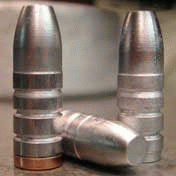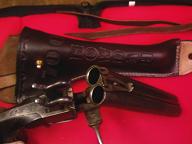

 The Accurate Reloading Forums
The Accurate Reloading Forums  THE ACCURATE RELOADING.COM FORUMS
THE ACCURATE RELOADING.COM FORUMS  Guns, Politics, Gunsmithing & Reloading
Guns, Politics, Gunsmithing & Reloading  Cast Bullets
Cast Bullets  Re: Is there an Engineer in the House?
Re: Is there an Engineer in the House?Go  | New  | Find  | Notify  | Tools  | Reply  |  |
| one of us |
Pecos, I love a good ale too! Samuel Smith's are my personal favorite, really like their oatmeal stout!!! Newcastle and Bass are right up there too! Problem is they are too filling and serve more as "food" than "drink" in my humble opinion. Just can get "relaxed" drinking ale, only filled up! ASS_CLOWN | ||
|
one of us |
Yes, I plan on proofing it. I will probably run the number through quickload to get an estimation. Maybe by the time that I actually get it built, I'll be able to afford some pressure measureing equipment. The underside of the barrel could be clearly marked with all info and be kept under the fore end. AC you are always trying to stir something up. Anything that I have left out of the equations would only serve to yield higher numbers. I'm assuming 100% safety factor to plastic deformation. So if I proof to 150% of my working max, then it shouldn't show any plastic deformation at all. There is a correlation between the strength of materials and the hardness, so the Rockwell test that I did should give me some information. I agree that I should have a spectral analysis done to see what the composition is and use that for the final calculations. Right now I have too many other projects to get to this one. | |||
|
| one of us |
Lar45, You really don't get it and I am too damned lazy to explain it to ya'! Good luck, you may need it! By the way, the receiver won't go until the barrel shank has gone! You are a double E, ain't ya',and a young one at that I'd wager (not necessarily in years just experience). It shows.  ASS_CLOWN | |||
|
| one of us |
I'm sorry I missed this thread but maybe I can comment now to save you from blowing yourself to pieces. I am a metallurgist and gunsmithing school graduate.you can NOT heat treat 1020 steel, the best you could do would be to case harden it .But the basic concept -taking an old gun designed for 12 ga and doubling the pressure to 35,000psi is INSANE.There has been conversion of old guns like the Remington rolling block but careful attention has to be made as to exactly which actionis used[there are 4 ].Something designed for the 12ga could safely be converted to low pressure cartridges as the 45 colt or 44 special .Iwouldn't go to 25'000psi of the typical BP cartridges like the 45-70 and certainly not anything like the 9.3x74.Handle old guns and old people like me gently !! | |||
|
| one of us |
Lar45, It is not nearly that simple! The stress calculations, if done properly, are complex. What you have done is not very accurate at all. If you post all the dimensions of the action, locks, and barrel shank (including thread) I may be able to help you out. I have been rather busy lately, though so it may take a few weeks. Regarding heat treating a LOW carbon steel like 1020. Better case carburize it! You CANNOT quench that 1020 fast enough to get it very hard, and even if you did it would more than likely warp up and look like a Ripples potatoe chip! In the old days manganese steels were widely used for ordnance. They can be annealed down to the same hardness range of plain carbon steels, but do heat treat easier and are MUCH tougher. You need to get a spectral analysis conducted to know what steel you are using. Savage99 is also correct about decarbonization. It isn't real wise to use these antique actions for hot rodding adventures. You would almost be better off to reverse engineer the action, correct it's weak spots, and make it out of SAE 4320 case carburized to a surface hardness of Rc57 = 62, effective case depth of 0.4 mm to 0.9 mm and a core hardness of Rc30-37. Now that would be a tough SOB! ASS_CLOWN | |||
|
| one of us |
Keep studying .. I think it sounds like a interresting idea. Could make a nice shotgun. | |||
|
one of us |
AC, I showed my equations and calculations to one of my Mechanical Engineering Professors who is also a gun nut. He said that it should give me a fairly good result. The parts that I left out of the total equation would only give me a low estimate of the strength so it will be stronger than calculated. I did have an offer to do the spectral analysis, but got busy and didn't send the sample off. I've started on a stock but haven't done much beyond that yet. | |||
|
| One of Us |
Simple explanation with out AC's BS If it was made for black powder loads it will be ok for light loads if it was made for smokeless loads you could shoot pretty much any load you wanted that is factory I am not sure of hot reloads. It looks like a beefed up reciever more so than my Rolling block and in that since it is a 1902 model that was rated for smokeless I can shoot safely the bottom end of the Marlin/Winchester loads in 45/70 which you could not with a older black powder era reciever. SO it depend on when it was made if made after smokeless came in and it is rated for such I do not see a problem with your conversion. If Black powder era light loads only. You could check around and ask at gunsmith forums on other sites and see what they say as well as asking your local smith to be on the safe side. If your local smith would consider the conversion and he is reputable it would be safe as no good gun smith is going to risk making a unsafe gun! | |||
|
| one of us |
Lar45, If you and your professor are comfortable with the ball park calculations you performed that is fine by me. I just wanted to inform you that your calculations are extremely simplistic and will provide considerable error from reality. I realize as well, that you have what you believe to be significant factors of safety baked into the mix as well (I say "believe" simply because the actual steel alloy is not truly known). To answer your question about threads and how they will fail in a rifle barrel. The threads will exhibit maximum strain, and therefore stress, in the thread root (minor diameter of a male thread, or major diameter of a female thread). Once the barrel shank fails the load is transferred to the receiver ring, the secondary failure is then the receiver ring. The end result is a split barrel and receiver ring and the potential for lots of steel to be in the air. <ouch> ASS_CLOWN | |||
|
| one of us |
jh45gun,      | |||
|
| one of us |
Quote: The proof is in the pudding, or in this case, have your pudding proofed. You could always have the finished gun proofed for your new, hot loading. For rifles, the proof load must be at least 1.3 times the normal max. The trick would be finding a 23 ksi shotshell load in any reputable load book. I do not know what the standards are for shotshells, but I wouldn't be surprised is the proof factor is higher. I'm sure the Birmingham Proof House in England would tackle this for you, but it wouldn't come cheap. If you make this rifle, do figure a way to properly proof the thing. You must take great care in measuring certain key dimensions before and after firing the proof load. "It didn't blow up" is not good enough. It is important that no part deform plastically. Chamber IDs and rim head space are likely two dimensions which must be properly measured. | |||
|
| one of us |
Figuring out a way to mark the completed gun for posterity is important too, it seems to me. It would be a shame to have a decendent or third party hurt by unintentionally overloading. I have a 30-30 rechambered to 307 Win where that could be a problem. How would you guys mark such a gun? | |||
|
one of us |
Hi all, I picked up a Hopkins and allen falling block 12ga action with the thought of makeing a heavy slug gun out of it. I rockwell tested it and it is 65 on the B scale. I took measurements and calculated strength on the action today. The hardness convereted to about 120 Brinell, so HBx500= tensil strength of about 60ksi. Looking on the charts seems real close to cold rolled 1020. So assuming hot rolled 1020 just to be safe with a yield strength of 38ksi and shear of 24ksi. case body diameter of .8" for thrust. The breach block side rails have a max shear yield of 38.4ksi chamber pressure. The action would have a max tension yield of 40ksi chamber pressure. I did the thin wall pressure vessel calculation on the barrel, 4140 23.56ksi, action 6.96ksi and 50BMG case 5.27ksi. I'm not sure if these add together or fractionaly. So about 35ksi max chamber pressure? In all my classes they never did go over the yield on threads. How is that calculated? I'm just thinking that it might be the thickness of halfway up the peak of the threads. So PIx diameter of median threadx 1/2 shank length? So if I allow 100% saftey factor then I could have a safe chamber pressure of 17.5ksi? Then if it will heat treat to a greater hardness I can go higher. Thoughts? We have a small furnace in the School Engineering lab that I could use to heat and oil quench, then temper. If the Steel isn't hardenable, then would it hurt it to try? I don't think that it would.  | |||
|
| one of us |
As steel ages carbon keeps coming out of the grain boundrys and it looses it's toughness. That gun was designed for blackpowder low pressure shotgun shells and it's weaker now than it was a century ago. Keep in mind that today even hammers go thru six separate heat treating operations. What to do with that action is to take it to a gun show and leave it there with somebody. | |||
|
one of us |
I went back and reviewed my Materials text book. If it's steel even a low carbon then it's hardenable. To what degree is the question. Reading some posts had me questioning if the world was flat or not. I need to take a trip to the library to find a book that gives specific hardenablility charts for different alloys and compositions. Anybody know of an online site that has that or similar? From looking at the charts for 1020-1040 I should be able to harden this to atleast twice the strength of what it is now. That would give me a safe working pressure of 30ksi which would put me beyond 700NE performance. IF it has lost carbon, I can put it in the furnace in a carbon rich environment and put it back in. | |||
|
| one of us |
THe carbon rich environment thing has good possibilities. I remember years ago, I believe in the old Dixie Gun Works catalog, a method I tried . It was for hardening frizzens, and involved wrapping the frizzen in leather, putting it in a fairly airtight can, and heating until cherry red. I THINK this was the method, as it has been thirty years since I did it. bottom line, it did harden the cheap ass frizzen on a Spanish lock hard enough to throw a shower of sparks, albeit a weak one. I believe this would be more of a case hardening, than full hardening. If you have the equipmnt to hold it in a high carbon state for an extended period, it may work out. I know when blacksmithing, the more you work the iron, the more carbon is driven into it by pounding. althouggh i doubt you want to do that to yopur action. you will also need to figure out wheter the metal is air or oil quench. I believe a salt water quench gives more hardness than straight water, and light weight oil was better than heavy, but it has been some years since I did any serious forge work. | |||
|
| one of us |
Lar, You shouldn't assume anything from a surface hardness test on a steel of unknown origin. Also there's no way of knowing how further heat treatment will affect the strength of the action because you don't know what steel you are starting out with. You could increase the hardness of case hardening & think you've increased the strength of the action. | |||
|
| one of us |
The shape of the earth is an imperfect sphere. The carbon that has leached out of the grain boundries will make the steel more brittle. Reheatreating it will not correct this unless you get it up to 2500F and melt it. You will need to go up to about 2550 if it's cast iron. Carborizing the action will increase the surface hardness and reduce wear and make the operation of the action smoother. It will not improve the toughness. It would take only a small filing from the action to spectrographic analysis. The place to go is where they do used oil analysis samples. They will advise you were to send it for a complete spectrographic analysis. The cost is about $60 and you will get a photograph. Of course if you do the breech block that's another $60. | |||
|
one of us |
Hair (i.e., floor sweepings from the barber/beauty shop) should work equally well as leather to pack a piece of soft iron in to heat and case harden it. I read that story of Turner's in the old Dixie catalog. He said he hardened a frizzen till the case met in the middle. Made a terrific shower of sparks, but the frizzen broke. | |||
|
| one of us |
I'm pondering such a chambering problem as well. I want to use plentiful 9.3x74R brass, but I don't think the gun is up to the full 49 ksi. I'm thinking of marking the barrel "9.3mm Special" followed by "36000 psi max" on the next line. You might call yours the ".30 Special". | |||
|
one of us |
Quote: Above statement show's your incredible level of maturity  | |||
|
| one of us |
Post deleted by ASS_CLOWN | |||
|
| one of us |
Lar45, Quote: Damn straight and f__king A!! Yes it does! As I stated earlier, GOOK LUCK I am afraid you are going to need it! ASS_CLOWN | |||
|
| One of Us |
 . Ass Clown...say good night to the whiskey bottle and take your drunk ass to bed. | |||
|
| new member |
why do you want to go and mess up a good old gun. Go by a mossberg and get the agony over with. | |||
|
| Powered by Social Strata |
| Please Wait. Your request is being processed... |
|
 The Accurate Reloading Forums
The Accurate Reloading Forums  THE ACCURATE RELOADING.COM FORUMS
THE ACCURATE RELOADING.COM FORUMS  Guns, Politics, Gunsmithing & Reloading
Guns, Politics, Gunsmithing & Reloading  Cast Bullets
Cast Bullets  Re: Is there an Engineer in the House?
Re: Is there an Engineer in the House?

Visit our on-line store for AR Memorabilia

